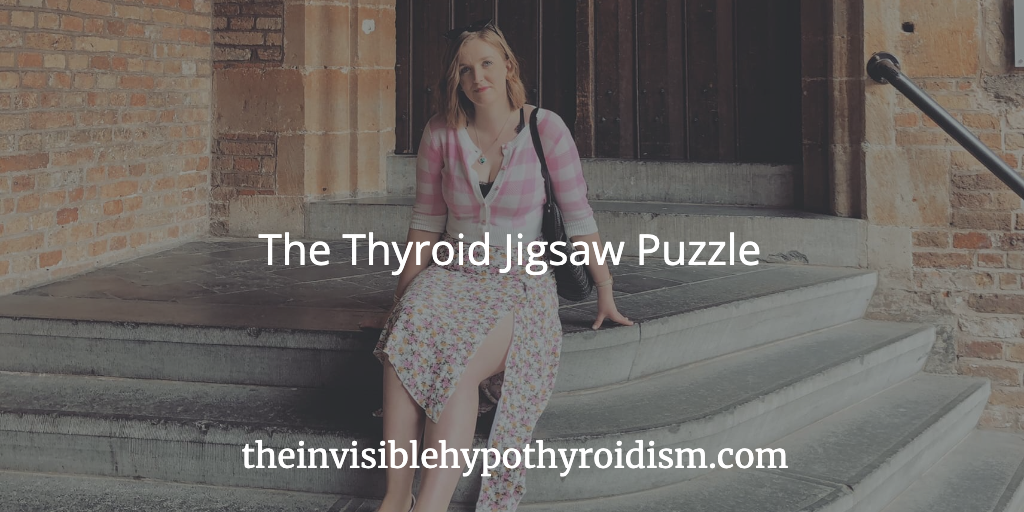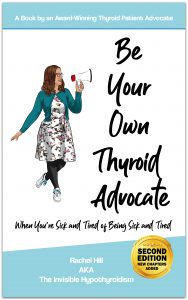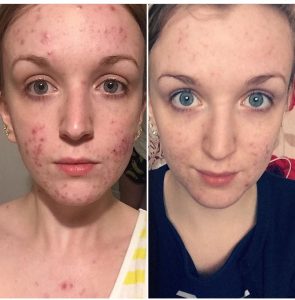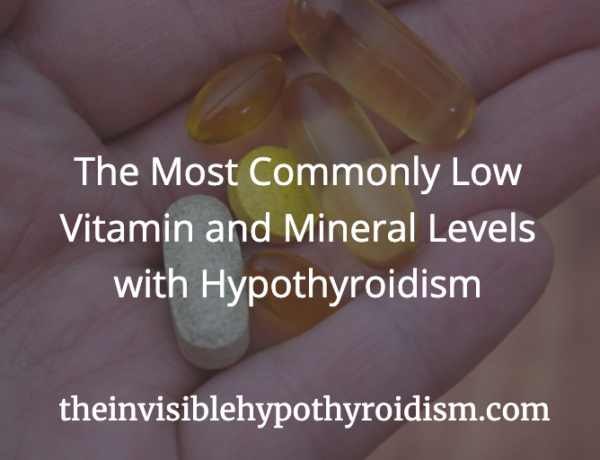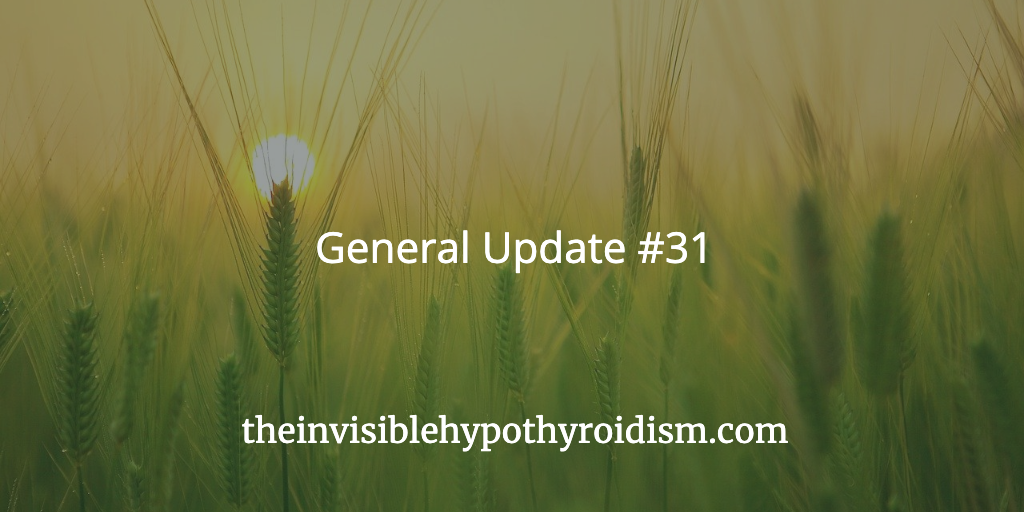TW: mental health, suicidal thoughts, body image, disordered eating
Originally published on 16th April 2020 Last updated on 29th July 2024
I have always said that getting well with hypothyroidism and Hashimoto’s is like piecing together a big thyroid jigsaw puzzle.
I’ve mentioned it various times in my public speaking presentations, newsletters, articles, books, podcast features, on social media and pretty much everywhere!
Why?
Because this has been the biggest lesson of all that I have learned since being diagnosed with autoimmune hypothyroidism and beginning the quest to take my health back.
My physical health, mental health and just about everything.
I live symptom-free of my thyroid condition these days.
Thyroid Medication Alone Doesn’t Always Help
For so many of us with hypothyroidism, taking thyroid hormone replacement medication (to replace low thyroid hormone levels) is just one part of the puzzle. A lot of thyroid patients take their medication everyday, something they are told ‘will make them feel all better’, yet still feel unwell or have lingering symptoms that affect their day to day.
I waited for my thyroid medication to ‘kick in’ and fix everything for months, but spoiler alert: it never did. I only got worse as time went on.
Was it the medication? No, but it was the other puzzle pieces that I was missing.
It took several years and a lot of trial and error, various interventions and lessons learned for me to regain my quality of life.
I was once so unwell with hypothyroidism and Hashimoto’s that I was barely able to work, my quality of life was hugely affected (I couldn’t get out of bed some days and my now-husband even had to help me get to the bathroom, and up the stairs), and I was only twenty-one years old.
I reached a point of being so unwell, physically and mentally, that I was depressed to the point of being suicidal.
I’m so thankful now that I somehow still saw a tiny sliver of hope and bit by bit, pieced my health back together by piecing together my wider jigsaw puzzle. I did this by researching for hours upon hours online, in books, devouring research and studies and speaking to thyroid experts.
Below you will find all the puzzle pieces that have helped me so far. These have helped me get back to good health and be able to live my life with thyroid disease no longer getting in the way.
As we’re all different, there are also some other puzzle pieces that haven’t applied to myself, but I’ve included them at the end, as they will apply to many of you still.
And remember, if you’d rather consume all of my information in one concise and easy to read place, check out my bestselling thyroid patient handbook Be Your Own Thyroid Advocate: When You’re Sick and Tired of Being Sick and Tired!
My Thyroid Jigsaw Puzzle Pieces:
1. Optimising My Thyroid Levels
One of the first things I did, and first thing I recommend to all thyroid patients, is to ensure they optimise their thyroid hormone levels. Your doctor may be saying that your test results are ‘fine’, ‘in range’ or ‘normal’, but this isn’t the same as optimised.
Optimal thyroid levels are way more specific than just ‘in range’. When they’re just in range, we can still have a boat load of symptoms and issues, yet when optimised, most if not all tend to resolve. This is a good place to start since addressing it may be all you need to do to return to good health.
What should you be looking for on your test results? Optimal thyroid levels are listed here.
Pleas ensure that the full, comprehensive set of thyroid tests are being run too and not just TSH. TSH alone doesn’t give the full picture. We need to optimise all thyroid levels and not just one.
If your TSH, Free T3, Free T4, thyroid peroxidase antibodies or thyroglobulin antibodies are not optimal, it could well be why you still don’t feel well and have ongoing issues, despite being on thyroid medication.
Optimising thyroid antibodies by putting Hashimoto’s in to remission, is discussed further down this list.
It’s worth knowing that you can order full thyroid panels yourself from online laboratories too. This was a big factor in me getting the treatment I needed. Find a UK lab here and a US lab here.
2. Changing Thyroid Medication Type
I was initially put on Levothyroxine medication for my hypothyroidism but changed to to Natural Desiccated Thyroid Medication (NDT) after six months, as my health (both mental and physical) were only deteriorating – and at a scary speed – on the Levothyroxine.
T4-only medications such as Levothyroxine and Synthroid work well for many people and raise their Free T3 and Free T4 to optimal, but not everyone. I unfortunately needed direct T3 in my medication because, like so many other thyroid patients, my body was not adequately converting the T4 in Levothyroxine to enough T3 to give me optimal thyroid levels.
3. Taking My Thyroid Medication Correctly
Neither the GP or pharmacist gave me any specific instructions on taking my thyroid medication correctly, so I learned the below information from a lot of personal research.
We should be taking our thyroid medication on an empty stomach and leaving at least one hour before eating or drinking anything (besides water) as it can affect the absorption and effectiveness.
It is also explained on thyroid medication packaging that we should be leaving at least four hours between taking thyroid medication and any pills containing iron, calcium, oestrogen and magnesium!
I started off taking my thyroid meds with my iron supplement (for anaemia) and contraceptive pill, which included oestrogen. This definitely didn’t help me get the most out of my thyroid medication at first.
You may also benefit from taking your thyroid medication at a different time of day e.g. T4 medication can be taken at night instead of in the morning, and NDT and T3 meds are often dosed several times a day instead of all in one go.
4. Addressing High Cortisol Levels
Adrenal dysfunction (though it is more accurately referred to as hypothalamic-pituitary axis dysfunction) seems common in those with thyroid issues.
I completed a saliva test to check for adrenal issues and discovered that my cortisol was high all day, contributing to symptoms of fatigue, struggling to sleep (feeling tired but wired), anxiety, hitting a slump in the afternoon, hot flushes, a weakened immune system and more. You can find adrenal testing here and here, as many doctors won’t test for it.
I addressed the adrenal dysfunction and brought my cortisol levels back to normal by improving everything else mentioned here. The approaches I took to address my mental and physical stress all impacted this.
I can’t stress how big a part adrenal dysfunction played in my quality of life. It made my mornings incredibly difficult as I felt dizzy, nauseas and fatigued beyond words, before it was ‘fixed’.
5. Learning How To Keep My Blood Sugar Balanced
Having Hashimoto’s meant I was more prone to wobbly blood sugar levels, so it has been crucial to ensure that I am keeping my blood sugar balanced and eating with a focus on this.
Being more aware of eating a lot less sugar and more protein and fats with every meal and snack, was enough to improve the fatigue, nausea, acne, hangriness (feeling hungry and angry) and sugar cravings, that I experienced due to blood sugar imbalances. It also helped my adrenal health. More info here.
6. Addressing My Disordered Eating
This is quite an emotional subject for me and I don’t discuss it an awful lot, but I have always struggled with my body image and after developing a thyroid condition, this only intensified with the weight fluctuations that came as a result.
With a history of disordered eating habits, I finally stopped yo-yo dieting and calorie counting, obsessing over weighing myself and losing pounds on the scale, and instead focused on feeding myself nutritious, wholesome food at the start of 2018. This was a huge shift in how I viewed my health and how I looked after myself.
I didn’t realise until I had given up these habits, just how much they were making my thyroid and endocrine health worse. Dieting can make you more hypothyroid, encourage blood sugar imbalances and worsen adrenal issues. My obsession with yo-yo dieting, restricting calories and focusing on my weight over how I physically felt were in fact not only hindering my ability to get my health back on track, but making it worse.
I feel that more people need to go back to eating healthily and exercising when they can, listening to their body and being more intuitive. I took some qualifications in diet and nutrition and made an effort to focus on feeding myself really nutritious, wholesome food. In particular, I incorporated a lot of the recipes from this book in to my weekly meals.
7. Changing My Exercise
I always saw exercise as something to off-set how many calories I was consuming and not something that was good for my physical and mental health. This is not a good way to view exercise!
Many of us are over exercising or doing the wrong kind of exercise for our hypothyroid bodies, and in fact making things worse. I was pushing my body beyond its limits by forcing cardio it just did not get on with, exacerbating adrenal dysfunction.
Repeatedly engaging in overly demanding exercise can cause a surge of biochemical imbalances to occur within the body, including the disruption of the hypothalamus-pituitary axis, which can reduce thyroid function. Intense cardio, marathon running and training, obsessive weight lifting etc. with little to no recovery time can all cause extreme stress to the body and particularly the thyroid.
It is important for us to know what is working and what isn’t. Listening to our bodies is crucial and taking things at our own pace helps us recover instead of going backwards.
I stopped the gym work-outs and implemented lots of long walks, swimming, yoga and dance classes. I went back to basics and then gradually increased what my body was allowed to do again. It felt great to be able to exercise without feeling awful afterwards.
Read about the best way to exercise with hypothyroidism here.
8. Raising Low Nutrient Levels / Taking Supplements
When we have hypothyroidism and Hashimoto’s, it is not uncommon to have low vitamin levels too.
These can include Iron/ferritin, Vitamin D, Vitamin B12 and folate (as well as others).
It’s worth checking these especially if you are tired a lot, have hair loss, bruise easily or get fatigued easily. I was anaemic in terms of iron and had very low Vitamin D levels. Supplementing these and raising the low levels to optimal helped a lot.
Over the years, the supplements I take have differed depending on my needs at any given time. No supplement is intended for lifetime use, so it’s important that they are regularly reviewed and blood tests are done often.
- I have supplemented Vitamin D, first at 10,000iu a day to raise my very low levels, then at 5,000iu and currently 4,000iu (as this is what personally maintains my Vitamin D levels at optimal). Always take Vitamin D with Vitamin K.
- I have supplemented Vitamin C at 2000mg per day
- I have supplemented Selenium at 200ug per day
- I raised my low iron levels up to optimal via supplementation
- I have supplemented Magnesium Citrate at 400mg per day
- I have supplemented Zinc and B Vitamins
Most vitamin levels can be checked via your doctor, but in my own experience, they’re not always happy to check them if they think ‘you’re probably fine’. However, we all know that looking ‘fine’ and what’s going on inside can be very different indeed. So I have listed some places for ordering tests below.
Vitamin D: UK test option here. UK and US test option here.
B12: UK and US test option here.
Folate/Folic acid: UK and US test option here.
Ferritin: UK and US test option here.
Iron, T.I.B.C., Transferrin Saturation: UK and US test option here.
9. Raising Low Stomach Acid
At the start of my thyroid journey, I experienced a lot of indigestion, acid reflux/heartburn, due to low stomach acid. Studies have found that people with hypothyroidism (and especially Hashimoto’s) often have low stomach acid.
However, many people going to the doctor with these complaints are given medications to lower stomach acid levels even further, such as Omeprazole, which is what I was given, and it did not help.
Without good stomach acid levels, I wasn’t able to absorb vitamins properly which impacted my vitamin levels, so I instead used apple cider vinegar daily (two tablespoons in warm water – with a straw) to help and this worked miracles. Off the Omeprazole and instead using this, I didn’t have acid issues anymore.
10. Addressing Too Much Oestrogen
About a year after my thyroid diagnoses, I learned that sex hormone imbalances were apparently common with thyroid patients and especially those with adrenal dysfunction.
After testing, I was diagnosed with low progesterone/oestrogen dominance, which created symptoms such as irregular periods, migraines, acne, PMT and more.
However, oestrogen dominance is not recognised in mainstream medicine, which is why I worked with a functional medicine practitioner on resolving it. I’m still undecided on whether I feel it’s a real condition, but I do know that the protocols she had me do for it helped my health.
I came off of hormonal birth control (as it can really mess with your hormones), and addressed my adrenal health, gut health (covered below) and bowel habits in order to bring oestrogen levels down.
The high oestrogen, high cortisol and gut issues were, I was told, all feeding in to each other and causing a vicious cycle.
11. Getting My Hashimoto’s in to Remission
Related Article: Why It’s Important to Know if You Have Hashimoto’s
Hashimoto’s causes around 90% of hypothyroidism cases and it’s good to know if you have it because if you do, there are things you can do to lower the antibodies and even get it in to remission – keeping antibodies low which stops any further damage being done to the thyroid gland.
Pretty much everything in this article helped to get my Hashimoto’s in to remission, including going gluten-free, taking Selenium and Vitamin D supplements, balancing my blood sugar and lowering high cortisol. Read in full, how I got my Hashimoto’s in to remission here.
Thyroid antibodies so high that the number they gave me was off the charts, and bringing those numbers back down in to normal ranges, has made a significant improvement in my thyroid health. Thyroid flare up days are significantly reduced and many thyroid symptoms just disappeared.
UK lab test for thyroid antibodies is available here, with a US lab here.
12. Removing Gluten From My Diet
Your diet can play a big part in how you feel. Many thyroid patients state they feel better when they cut out gluten, and although I was initially very skeptical and avoided going gluten-free for a long time, I was astounded at the improvement in my health when I eventually did.
Thyroid brain fog disappeared within a few weeks, along with heart palpitations, my acne significantly improved and I had more energy.
See my post: 9 Thyroid Symptoms That Improved by Going Gluten-Free here.
Why do so many thyroid patients feel better off gluten? More information here.
As of 2024, NICE Guidelines recommend that all autoimmune thyroid patients (those with Graves’ or Hashimoto’s) are screen for coeliac disease at diagnosis. Most people with hypothyroidism also have Hashimoto’s (as the cause) so this is important. Research shows that people with coeliac disease have a 1.5% to 3.8% chance of developing autoimmune thyroid disease, so there is a big correlation between the two conditions. If you test negative but develop possible symptoms at a later date, it is recommended you be screened again, as you can develop it at any time.
13. Removing Alcohol
Alcohol wasn’t something I eliminated from my life until more recently, in 2019. I enjoyed the social aspect of drinking alcohol occasionally, but I was also very aware of the thyroid flares that ensued afterwards.
I almost always felt unwell following alcohol, including digestive complaints, reflux, lethargy, muscle aches and pains, headaches, acne and brain fog.
I eventually decided to just go without alcohol and although weird at first when in social situations, it soon didn’t feel like an issue and my thyroid condition and symptoms are more well-managed as a result. I realise now that alcohol was significantly impacting how well-managed my thyroid condition was.
14. Going Caffeine-Free
Giving up caffeine for my thyroid health was something I did earlier on, however.
Experiencing debilitating migraines every week which impacted work and my personal life alike, I switched to decaf tea (and have never liked coffee anyway) and felt better in terms of energy levels and diminished migraines.
15. Avoiding and Eliminating Toxins
There are certain substances such as fluoride and mercury, which are said to be toxins to the body and can interfere with thyroid function, however, whereas other thyroid patients have fitted filters on their showers and taps at home to remove the fluoride and toxins from water, or had mercury fillings removed, I haven’t gone this far (and don’t have any fillings or dental issues anyway).
I have however, switched out some personal beauty products for organic versions, changed to a BPA-free water bottle and use Epsom Salts once a week or so in the bath (or in a foot soak) to promote detoxification.
16. Learning How To Manage Stress Better
Learning how to manage my stress levels better was imperative if I was to get my thyroid and adrenal health under control. I could never really get in to meditation, but I did begin to set firmer boundaries on my time. Learning to say ‘No’ and better prioritise my time and needs felt good.
No more overworking and more time off social media. Less time doing tasks that other people should have been doing themselves and more time reading books, making time for yoga, baths and walking in nature.
I also tried CBT and saw a Step 4 Therapist on the NHS to help me learn techniques for managing anxiety and stress more effectively. This helped a lot too. Learning how to live as a HSP also helped.
17. Learning About The Spoon Theory
This one simple thing changed my whole outlook on living with a chronic health condition.
The spoon theory is a metaphor those with a disability, chronic illness, health condition and/or autoimmune disease (such as hypothyroidism or Hashimoto’s), can use to explain their reduced amount of energy and how they manage their energy levels effectively.
Whereas people with no ongoing health issues do not need to worry about running out of energy, many of us with thyroid issues do, so learning how to manage our energy use wisely can be a huge game changer.
We can be more at risk of over-exhausting and expecting too much of ourselves, compared to others, so it’s important to rediscover your energy levels and expectations. Read about the spoon theory here.
18. Addressing My Sleep Routine
This is an obvious one, but so many of us don’t do it: implement and stick to a good sleep routine.
We can all aim to get 7-9 hours of sleep a night, getting in to bed by 10 or 11pm to support adrenal health. My sleep schedule used to be all over the place and thanks to adrenal dysfunction, I could be awake until 3am some nights/mornings.
I started to limit electronic usage in the evenings, particularly 1-2 hours before bedtime and made sure to leave work at the office. I made it my routine to be in bed for between 10 and 11pm every night, in a completely dark room, and after a while, it just seemed to click.
At first, I could lie awake for ages, but now, I finally get in to bed and fall asleep without an issue soon after. It took a while for my body to get the message and fall in to the routine of feeling sleepy at that time, but it was worth the persistence. I also make sure to exercise everyday so as to encourage the readiness to sleep.
19. Addressing My Morning Routine
There were many ways I had to improve how I started my day, which included making sure I was taking my thyroid medication properly, avoiding the pointless social media scrolling, doing some gentle exercise and eating the right type of breakfast. Read more here.
20. Changing My Job
There came a time when I just had to review my job. The type of work I was in (event management) just wasn’t working for my health anymore – it now left me feeling exhausted – and even the hours were too much to keep up with. There were a lot of long days and huge amounts of stress.
Moving to a calmer role, working less hours (which I had to figure out how to afford, but got there in the end) and realising what I needed to prioritise at work, made all the difference. It was also important for me to make sure I had the correct work-life balance, in order to keep stress levels low and overcome the adrenal issues.
21. Addressing My Gut Issues
Increased intestinal permeability and candida (a yeast overgrowth) is very common in those with hypothyroidism and Hashimoto’s, since poor gut health is often cited to needing to be in place in order to trigger the condition in the first place. Yet most of us don’t address this huge thyroid jigsaw puzzle piece.
Addressing my gut health was one of the biggest pieces of my puzzle.
A UK test for Candida can be found here and a US test here.
I improved my gut health and fixed the excess yeast by:
- Taking probiotics
- Taking Digestive Enzymes
- Drinking Bone Broth
- Using apple cider vinegar
- Using Grapefruit Seed Extract
- Being on the candida diet for a few months
and taking various supplements to support good gut health.
Just how much slotting this jigsaw piece in to place improved my health, truly astounded me. The oestrogen dominance seemed to resolve, along with the high cortisol adrenal dysfunction and my Hashimoto’s went in to remission.
Other Thyroid Jigsaw Puzzle Pieces:
These puzzle pieces weren’t required by myself but are by many other thyroid patients.
Trying a Different Brand of Thyroid Medication
There are different brands of thyroid medication. You could try another brand of your medication type, to see if one works better for you than another. It’s also worth noting that some patients report generic medications not being as effective as their usual branded ones, so make sure the pharmacist always gives you the same type if this is the case.
PCOS
Polycystic Ovary Syndrome is more prevalent in those with thyroid conditions Hypothyroidism and Hashimoto’s.
For a PCOS Blood Test, click here.
Other Food Sensitivities
Many thyroid patients find that they have to do more than just remove gluten from their diet. Removing dairy, soy, nightshades, all grains and trying various diets such as AIP or Keto has helped others.
I went dairy-free for several months to see if it helped my gut health and acne, but saw no benefits whatsoever.
Read my comprehensive article about diet and thyroid disease here.
Low Dose Naltrexone (LDN)
You could also explore LDN with your doctor. Due to Hashimoto’s being an autoimmune disease, LDN can be beneficial by reducing high thyroid antibodies, stopping the progression of the autoimmune disease or even reversing the disease. Besides improving endorphin production, LDN can also help reduce inflammation and encourage healing.
Lyme Disease
Some thyroid patients also have undiagnosed and untreated Lyme Disease, which can contribute towards symptoms. See a test for Lyme Disease here.
EBV (Epstein-Barr virus)
Viral infections, including EBV, are one of the most frequently considered environmental factors involved in autoimmunity. Checking if you have activated EBV and working to address this could be a big factor.
Exposure to mould
Exposure to mould has been cited to trigger thyroid disease as well as worsen it. Looking for signs of it in your home or surroundings may be an idea.
MTHFR
Around half of the general population have the MTHFR gene variation, which can present with elevated homocysteine levels. These have been associated with inflammation, depression, heart disease, pregnancy complications and even miscarriages.
MTHFR prevents people from properly methylating – one of the body’s detox processes that helps eliminate toxins. This can lead to symptoms such as brain fog, poor mental health and vitamin deficiencies.
Learning how to support your body if you have this gene variation can be useful.
H. pylori
H. pylori has been implicated in various autoimmune conditions, including Hashimoto’s, contributing to low stomach acid and food sensitivities. More info here.
Have you explored these thyroid jigsaw puzzle pieces?
You can click on the hyperlinks in the above post to learn more and see references to information given.

